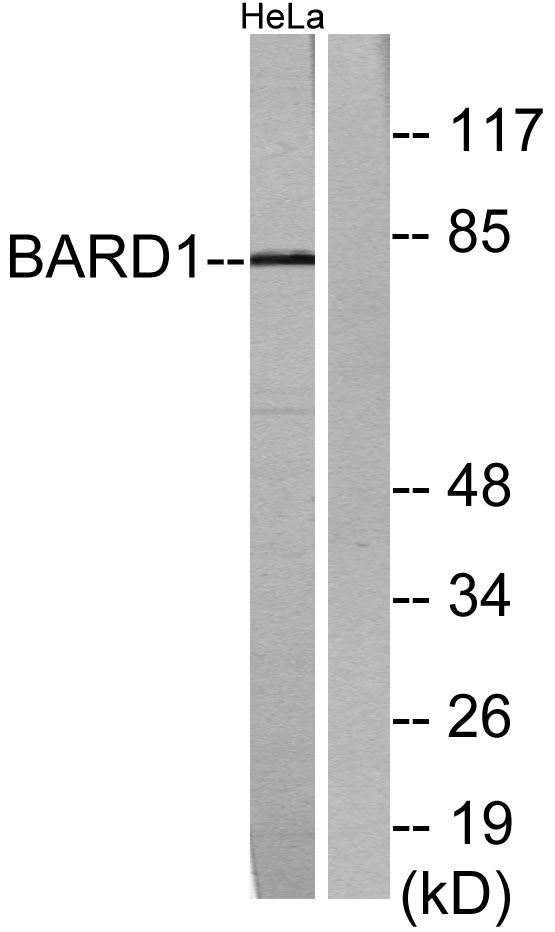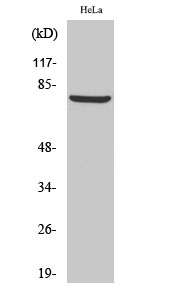产品名称
BARD1 Rabbit Polyclonal Antibody
别名
BARD1; BRCA1-associated RING domain protein 1; BARD-1
蛋白名称
BRCA1-associated RING domain protein 1
存储缓冲液
Liquid in PBS containing 50% glycerol, 0.5% BSA and 0.02% New type preservative N.
Human Gene Link
http://www.ncbi.nlm.nih.gov/sites/entrez?db=gene&term=580
Human Swissprot No.
Q99728
Human Swissprot Link
http://www.uniprot.org/uniprotkb/Q99728/entry
Mouse Swissprot No.
O70445
Mouse Swissprot Link
http://www.uniprot.org/uniprot/O70445
免疫原
The antiserum was produced against synthesized peptide derived from human BARD1. AA range:1-50
特异性
BARD1 Polyclonal Antibody detects endogenous levels of BARD1 protein.
稀释度
WB 1:500 - 1:2000. IHC 1:100 - 1:300. ELISA: 1:5000.. IF 1:50-200
宿主
Polyclonal, Rabbit,IgG
背景介绍
This gene encodes a protein which interacts with the N-terminal region of BRCA1. In addition to its ability to bind BRCA1 in vivo and in vitro, it shares homology with the 2 most conserved regions of BRCA1: the N-terminal RING motif and the C-terminal BRCT domain. The RING motif is a cysteine-rich sequence found in a variety of proteins that regulate cell growth, including the products of tumor suppressor genes and dominant protooncogenes. This protein also contains 3 tandem ankyrin repeats. The BARD1/BRCA1 interaction is disrupted by tumorigenic amino acid substitutions in BRCA1, implying that the formation of a stable complex between these proteins may be an essential aspect of BRCA1 tumor suppression. This protein may be the target of oncogenic mutations in breast or ovarian cancer. Multiple alternatively spliced transcript variants encoding different isoforms have been found for this gen
细胞定位
Nucleus. During S phase of the cell cycle, colocalizes with BRCA1 into discrete subnuclear foci. Can translocate to the cytoplasm. Localizes at sites of DNA damage at double-strand breaks (DSBs); recruitment to DNA damage sites is mediated by the BRCA1-A complex.
功能
caution:It is uncertain whether Met-1 or Met-26 is the initiator.,disease:Defects in BARD1 gene are found in primary breast, ovarian and uterine cancers.,function:The BRCA1-BARD1 heterodimer coordinates a diverse range of cellular pathways such as DNA damage repair, ubiquitination and transcriptional regulation to maintain genomic stability. Plays a central role in the control of the cell cycle in response to DNA damage. Acts by mediating ubiquitin E3 ligase activity that is required for its tumor suppressor function. Also forms a heterodimer with CSTF1/CSTF-50 to modulate mRNA processing and RNAP II stability by inhibiting pre-mRNA 3' cleavage.,pathway:Protein modification; protein ubiquitination.,PTM:Processed during apoptosis. The homodimer is more susceptible to proteolytic cleavage than the BARD1/BRCA1 heterodimer.,similarity:Contains 1 RING-type zinc finger.,similarity:Contains 2 BRCT domains.,similarity:Contains 3 ANK repeats.,subcellular location:During S phase of the cell cycle, colocalizes with BRCA1 into discrete subnuclear foci. Can translocate to the cytoplasm. Localizes at sites of DNA damage at double-strand breaks (DSBs); recruitment to DNA damage sites is mediated by the BRCA1-A complex.,subunit:Homo- and heterodimer. Heterodimer (RING-type zinc finger) with BRCA1. Heterodimer (via ANK repeats and BRCT domains) with CSTF1/CSTF-50. Component of the BRCA1-A complex, at least composed of the BRCA1, BARD1, UIMC1/RAP80, FAM175A/Abraxas, BRCC3/BRCC36, BRE/BRCC45 and MERIT40/NBA1.,
纯化
The antibody was affinity-purified from rabbit antiserum by affinity-chromatography using epitope-specific immunogen.



